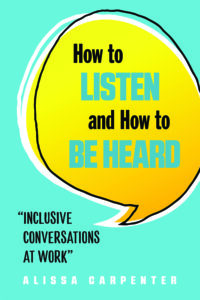According to Gallup’s State of the American Workplace report, only 30% percent of employees strongly agree that their opinions count at work. So, where does that leave the other 70%?
In my work as the founder of Everything’s Not OK and That’s OK and while researching my new book, How to Listen and How to Be Heard: Inclusive Conversations at Work, I have learned that people want to be included. As humans, we want to be part of the decisions that impact us, our teams and our organizations as a whole. But often times, integral people are left out. Intentional or not, this leads to disengagement, turnover, office gossip, and avoidable errors.
Right now, five generations are out there working together, ranging in age from 16 to over 75. And within these generations, more and more diversity has entered the mix —gender, race, ethnicity, religion, and more. Mixed in with those differences, we have all sorts of personalities.
Each individual brings their own way of seeing things and expressing them into their careers. No two people—even if they share similar backgrounds or demographics—have the same perspective.
As an individual contributor, people manager, or somewhere in between, we all have the power to create inclusive spaces. And we all have the ability to strengthen our communication skills to ensure our message is understood. Both of these skill sets need to work together to help move the needle and allow for the other 70% to get their opinions heard.
Be clear on what you’re trying to communicate and to whom
Understanding and identifying your message is crucial. It’s one thing to have an idea of what you want to say but another to create a clear and concise message. And once you know what the message is, you need to know whom to speak to.
The more clarity you can provide, the easier it is to be heard and not overshadowed by confusing messaging. Before starting a conversation, think about:
- The specific request, question, and/or statement you want to make. What exactly are you trying to get across?
- What you are looking to get out of this interaction. You may not get the outcome you’re looking for, but you need to know your desired result.
- What information you need to supply this person to illustrate your point (i.e.; data, facts, stories, etc.)
- What information can be left out and would be considered “extra” and unnecessary information
- The intended receiver. Who is the decision maker or individual you are trying to reach and why?

Identify how they like to communicate
Philosopher Marshall McLuhan once said, “The medium is the message.” How we communicate our message is not only as important, but arguably more important than the actual words or phrases we are using. If we are trying to have a conversation on one platform and the other person is not responding, we are essentially speaking to ourselves. We need to identify not only what we want to say and who we want to say it to, but also how to do it.
With five generations and various communication channels it can be difficult to find the most effective way to have a conversation. From email, phone and text to other platforms like social media and cloud sharing, we all prefer a different method. And we can’t assume that all people within a specific generation or demographic prefer the same medium. Start having conversations that address:
- The best way to communicate for everyday questions and/or emergencies (phone, email, text, in person, IM)
- Preference for long form communication (background information or high level with bullets)
- Expectations for using a certain medium
- When and how to communicate during off hours (if necessary)
- Defining necessary versus unnecessary after hours communication
Find a balance between being heard and listening
Half (if not more) of the work to being heard involves active listening. The louder and more frequently someone talks doesn’t mean more people are paying attention. Sure, people can hear them talking but that doesn’t mean they’re retaining or even listening to what they’re actually saying.
To be a more active listener:
- Make eye contact
- Put devices out of view (not just face down on the table)
- Uncross arms, face the person, and smile and/or nod (when appropriate)
- Ask clarifying questions when necessary
- Pay attention to non-verbal cues
- Keep an open mind during the conversation and don’t fixate on what you want to say next

Move past your agenda
You might want a raise or have an amazing idea to share, but why should someone pay attention? Just because something is exciting to you doesn’t mean it is to everyone else. Do these things you’re trying to communicate help the organization or your team or do they just benefit you? If you’re finding that you’re trying to have a conversation that is all about you, and people are ignoring you, identify:
- Pain points. You tend to get more buy-in if you’re helping to resolve a pain point than setting your own agenda
- Whether or not your message is being received or if you need to tweak the language or medium to better serve the recipient. This especially applies when you’re speaking to a person of authority. If you want your message to be received, you may need to defer to their communication preference.
- How helping you helps the whole
Be a good partner
We tend to listen to and value people we have a relationship with. According to the same Gallup report referenced earlier, “Employees are less inclined to stay with a job simply because it provides them with a paycheck. They signed up for a certain experience, and if they do not get that experience, they are more than willing to look elsewhere.” And part of that experience is culture built on workplace relationships.

Showing support for a peer’s work by using the “Yes, and…” approach or asking what you can do to help them with their role can go a long way. To get started on building a workplace relationship try:
- One-on-one meetings (regular conversations between a supervisor and their employee)
- Reverse mentoring sessions (employees of varying generations in a mutually beneficial partnership)
- Skip-level conversations (higher up leadership meets with employees more than one level below them)
- Stay conversations (dialogue around what someone needs or what would keep them in an organization)
- Unforced “happy hour” during work hours (workplace relationship building outside the office)
While it is important to reflect on these strategies, it’s also crucial to remember that there are no quick fixes. Working toward change takes time. It takes conscious effort. People and environments are constantly changing and evolving, and each individual coworker or supervisor is always a person all their own.
But also remember this: Every employee within an organization can provide value. Every. Single. One. Everyone is in a position of power to bring change to their role, to their unit, and to the overall success of an organization. What makes you different is what makes you great and taking the time to actively listen when someone is sharing their thoughts provides the space and opportunity for more people to be valued and heard.
- Cultivating Relationships - July 20, 2021
- Empowering Our People - July 13, 2021
- Finding Purpose - July 6, 2021




